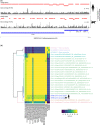First genome sequencing of SARS-CoV-2 recovered from an infected cat and its owner in Latin America
- PMID: 33421326
- PMCID: PMC8014608
- DOI: 10.1111/tbed.13984
First genome sequencing of SARS-CoV-2 recovered from an infected cat and its owner in Latin America
Abstract
An 11-year-old male mixed-breed cat, with exclusively indoor life, presented 3 cough episodes after the owners tested positive by RT-PCR for SARS-CoV-2. The house is inhabited by 5 people (3 adults and 2 children), and 2 of the adults have shown mild symptoms associated with throat discomfort. The cat was vaccinated, had no history of any previous disease, and tested negative for feline coronavirus (FCoV), feline immunodeficiency virus (FIV) and feline leukaemia virus (FeLV). Rectal sample collected from the cat was positive for SARS-CoV-2 by RT-PCR. Viral genome sequences recovered from human and cat samples showed an average 99.4% sequence identity. This is the first report of genome sequences of SARS-CoV-2 recovered from a cat and its owner in Latin America.
Keywords: Brazil; SARS-CoV-2; cat; next-generation sequencing.
© 2021 Wiley-VCH GmbH.
Conflict of interest statement
There was no conflict of interest with others.
Figures

References
-
- Belgium OIE. National Veterinary Services of Belgium (2020). A case of a Belgian cat positive for Covid‐19. Retrieved from <https://www.oie.int/fileadmin/Home/eng/Our_scientific_expertise/docs/pdf...>
-
- Davidson, M. (2020a). OIE notification: Tigers and lions New York: World Organisation for Animal Health. (Information received on 06/04/2020 from Dr Mark Davidson, Associate Administrator, USDA‐APHIS, United States Department of Agriculture, Washington, United States of America. OIE, SARS‐CoV‐2/COVID‐19, United States of America). Retrieved from https://www.oie.int/wahis_2/public/wahid.php/Reviewreport/Review?page_re...
Publication types
MeSH terms
LinkOut - more resources
Full Text Sources
Other Literature Sources
Medical
Miscellaneous

